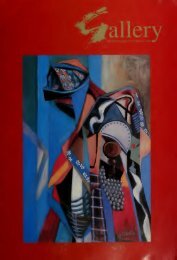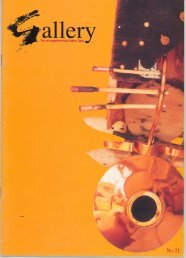Gallery : the art magazine from Gallery Delta
Gallery : the art magazine from Gallery Delta
Gallery : the art magazine from Gallery Delta
You also want an ePaper? Increase the reach of your titles
YUMPU automatically turns print PDFs into web optimized ePapers that Google loves.
Grazyna Zaucha, <strong>art</strong> historian and curator of <strong>the</strong> Choma<br />
Museum, investigates <strong>the</strong> growth of graphic <strong>art</strong> in Zambia<br />
, Zambia<br />
identities In print<br />
Zambian Graphics: A Retrospective<br />
Exhibition of Printmaking in Zambia<br />
opened at <strong>the</strong> Choma Museum, Zambia, on<br />
9 March 1996, featuring 60 works of nine<br />
<strong>art</strong>ists <strong>from</strong> various private collections.<br />
While emphasising individual<br />
achievements, <strong>the</strong> exhibition is at <strong>the</strong> same<br />
time, a testimony to <strong>the</strong> successful<br />
introduction of this <strong>art</strong> form in Zambia. A<br />
general tendency towards figurative<br />
representation is apparent but a more recent<br />
trend towards abstraction and experimental<br />
work is also evident. The exhibition shows<br />
clearly that <strong>the</strong> <strong>art</strong>ists are not so much<br />
concerned with breaking new ground as<br />
with using <strong>the</strong> Western techniques in order<br />
to explore <strong>the</strong>ir own identities.<br />
On display are <strong>the</strong> works of exponents such<br />
as Cynthia Zukas. practising graphic <strong>art</strong>ist<br />
since 1964, and Henry Tayali, <strong>the</strong> first<br />
formally trained black Zambian <strong>art</strong>ist.<br />
These are boldly counterpointed by <strong>the</strong><br />
mainly black and white prints of <strong>the</strong> Lusaka<br />
Artists Group, Bert Witkamp, David<br />
Chibwe, Fackson Kulya and Patrick<br />
Mweemba. The new directions are<br />
reflected in <strong>the</strong> works of Andrew<br />
Makromalis. Lutanda Mwamba and Patrick<br />
Mumba.<br />
There are various interpretations as to<br />
when, how and why this p<strong>art</strong>icular <strong>art</strong> form<br />
became embedded in Zambia. Two<br />
explanations of <strong>the</strong> beginnings of <strong>the</strong><br />
Zambian graphics are p<strong>art</strong>icularly popular.<br />
(top) Bert Witkamp, Beauty is a Cure<br />
for Madness, 1980, 15 x 20cm, linocut<br />
(above) Henry Tayali, Madam and <strong>the</strong><br />
Rains, 1982, 40 x 23cm, woodcut<br />
One opinion has it that printmaking became<br />
a major <strong>art</strong> form in Zambia due to<br />
difficulties in obtaining <strong>art</strong> materials. This<br />
interpretation alludes to <strong>the</strong> economic<br />
problems which Zambia st<strong>art</strong>ed to face <strong>from</strong><br />
<strong>the</strong> mid 70s onwards. It cannot be denied<br />
that <strong>the</strong> production and dissemination of<br />
certain <strong>art</strong> forms might be constrained by <strong>the</strong><br />
economy. However a clo.ser look at<br />
printmaking reveals that techniques such as<br />
etching, wood cutting, lino cutting and<br />
screen printing involve specialised materials<br />
which may be expensive and not easily<br />
obtained. Leaving aside <strong>the</strong> complicated<br />
requirements of etching and <strong>the</strong> relative<br />
simplicity of screen printing, even wood and<br />
lino cutting require base materials, knives,<br />
printing inks, papers, rollers and a relief<br />
press. Therefore an argument based solely<br />
on economics does not offer a sufficient<br />
explanation.<br />
The second opinion as to <strong>the</strong> emergence and<br />
popularisation of graphic <strong>art</strong> in Zambia<br />
accords overriding importance to <strong>the</strong> Art<br />
Centre Foundation, toge<strong>the</strong>r with <strong>the</strong><br />
influence of <strong>the</strong> two <strong>art</strong>ists most closely<br />
associated with it, Cynthia Zukas and Henry<br />
Tayali. The Art Centre Foundation (ACF)<br />
was established as a national body<br />
responsible for <strong>the</strong> promotion of visual <strong>art</strong> in<br />
Zambia. To this end. <strong>the</strong> Foundation<br />
maintained <strong>the</strong> national collection of <strong>art</strong> and<br />
organised annual exhibitions. Its direct<br />
contribution to <strong>the</strong> development of<br />
printmaking consisted of providing a 11







